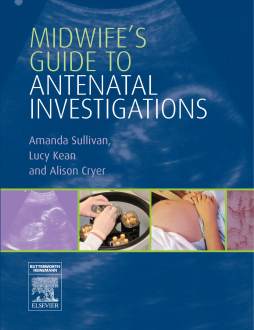
BOOK
Midwife's Guide to Antenatal Investigations E-Book
Amanda Sullivan | Lucy Kean | Alison Cryer
(2006)
Additional Information
Book Details
Abstract
This book serves as a guide to a comprehensive range of diagnostic screenings and tests used during pregnancy. It links routine antenatal care with specialist investigations, describing when follow up is required and how to interpret the results. Designed for ease of reference, this resource helps midwives make informed, evidence-based clinical decisions. It also provides guidance about how best to discuss sensitive issues with mothers and how to provide support to parents receiving bad news. This book is an essential resource for midwives and other health professionals involved in delivering antenatal care to women and their families. Expert contributors ensure that the information is reliable and up-to-date, and the easy-to-use format guides practitioners through each procedure, interpretation of results, and appropriate interventions.
- The only book of its kind, developed to provide midwives with a comprehensive guide to antenatal investigations in an accessible format.
- Includes a range of clinical scenarios and considers the parents' point of view, which brings the tests to life and helps midwives understand the clinical application and impact of investigations.
- A chapter written by the national charity ARC (Antenatal Results and Choices) relates first-hand accounts from parents whose newborns have been diagnosed with an abnormality, providing insight into how best to provide sensitive care to parents facing difficult situations.
- Extensive illustrations, diagrams, summary tables and ultrasound scan images make the information in the book clear and understandable.
- Best practice guidance from National Screening Committee (NSC) are provided to ensure all practitioners are aware of the NSC policy.
- Clinical guidance is supported by explanations of common and specialist terminology and developments in technology.
- The fundamental principles underlying genetic and chromosomal testing are described.
- The historical and cultural aspects of antenatal investigations are discussed, as well as the potential impact of these technologies on the future role of the midwife.
Table of Contents
| Section Title | Page | Action | Price |
|---|---|---|---|
| Front Cover | Cover | ||
| Midwife's Guide to Antenatal Investigations | iii | ||
| Copyright Page | iv | ||
| Contents | v | ||
| Contributors | vii | ||
| Preface | ix | ||
| SECTION 1: CLINICAL PRACTICE IN CONTEXT | 1 | ||
| Chapter 1. The development of fetal Investigations. historical and sociological perspectilves | 3 | ||
| Chapter 2. Involving parents. Information and Informed decislons | 17 | ||
| Chapter 3. Pergnancy loss, breaking bad news and supportingparents | 31 | ||
| SECTION 2: MATERNAL INVESTIGATIONS | 43 | ||
| Chapter 4. Haematology in pregnancy | 45 | ||
| Chapter 5. Maternal diseases in preganancy | 69 | ||
| Chapter 6. Infections in pregnancy | 87 | ||
| SECTION 3: FETAL INVESTIGATIONS | 107 | ||
| Chapter 7. First trimester ultrasound scans | 109 | ||
| Chapter 8. The second Trimester detailed anomaly scan | 125 | ||
| Chapter 9. Blochemical markers in Down's syndrome screening | 135 | ||
| Chapter 10. Chromosomal and genetic testing | 147 | ||
| Chapter 11. Assessment of fetal wellbeing | 169 | ||
| SECTION 4: ONGOING DEVELOPMENTS | 181 | ||
| Chapter 12. Antenatal invesigations for the fruture | 183 | ||
| Index | 191 |
